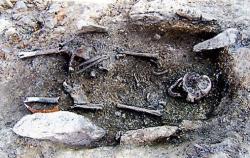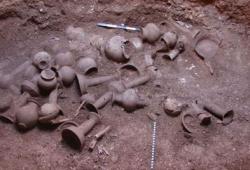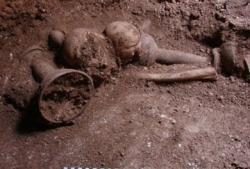30 DECEMBRE
INDI-UNI : ANTHROPOLOGY - ARCHAEOLOGY
INSCRIPTION 2012 COURS A DISTANCE
REGISTRATION 2012 ONLINE COURSES
ITALIE – Vatican - Début décembre, la découverte d’une quarantaine de structures funéraires et plus de 200 tombes sous un parking du Vatican était révélée par l’Osservatore romano. Les sépultures datant des I et IIe siècles de notre ère, furent recouvertes d’un éboulement de boue vers le milieu du IIe siècle. D’autres tombes furent par la suite installées au-dessus des premières sépultures. Les tombes étaient organisées en petites parcelles, reliées entre elles par de petits sentiers, et qui tous se rejoignaient dans la via Triumphalis. Cette partie antique de la ville avait déjà été découverte dans les années 1950. En 2003, de nouvelles découvertes sont faites sur le site et des fouilles entreprises, permettant la mise au jour de ces nouvelles sépultures. Plusieurs sépultures nobiliaires du Ier siècle sont dans un état de conservation exceptionnel, avec notamment des décors floraux ou linéaires à l’intérieur et peintes à l’intonaco rouge à l’extérieur. De nombreux autels et sarcophages permettent également d’éclairer des rituels funéraires jusque là peu connus. En outre, les inscriptions relevées dans les sépultures mettent au jour une organisation sociale particulière, comme par exemple le nom de certaines familles tombées dans l’oubli. Un relief étonnant était ainsi placé dans la tombe des Natronii, celui de Tiberius Natronius Zmaracdis, 4 ans, 4 mois et 10 jours, qui donne un portrait mélancolique et émouvant du petit garçon. D’autres stèles appartiennent à des familles liées entre elles mais également peut-être avec le pouvoir, et sans doute avec Agrippine, la mère de Néron. Ce sont surtout deux stèles provenant de ces tombes qui ont retenu l’attention puisque ce sont celles de deux artistes, le sculpteur Tiberius Claudius Thesmus (première moitié du 1er siècle de notre ère) représenté en train de réaliser un buste et le scénographe Alcimus (esclave de Néron et responsable du Théâtre de Pompée).
http://www.info-histoire.com/actualite/antiquite/9728/decouverte-de-plus-de-200-tombes-du-debut-de-notre-ere-sous-la-cite-du-vatican/
FRANCE –  Caramany - De 1992 à 1994, plusieurs campagnes de fouilles archéologiques menées sur les terres prochainement immergées par la mise en eau du barrage de l'Agly, révélaient de nombreux sites de différentes périodes. Ces interventions, effectuées sur des secteurs limités, laissaient entrevoir un fort potentiel pour tout ce secteur de la vallée, intensément fréquenté tout au long de la préhistoire et de l'histoire. Cette éventualité se confirmait dernièrement par la découverte, par G. Bergès, pêcheur émérite (et très observateur !), sur la presqu'île proche du récent viaduc de deux os longs parallèles qui dépassaient d'un talus battu par les eaux. Les archéologues du Pôle archéologique départemental, contactés, identifiaient rapidement ces os comme humains, et par là même la présence d'une tombe, sommairement limitée par quelques blocs. La fouille de la sépulture permettait de dater cette dernière du bas empire romain, soit du IVe siècle après J.-C., à partir des fragments des vases funéraires contenus dans la tombe, auxquels étaient associés un outil en fer à usage agricole, ainsi qu'une bague en bronze. L'exploration des abords de la tombe s'avérait stérile, la sépulture étant isolée. Cette situation pourrait paraître anormale, toutefois il n'en est rien. Il est en effet assez courant qu'à cette période, le maître des terres alentours, peut-être le propriétaire de la ferme romaine contemporaine du Pla de l'Aïgo, toute proche, fouillée en 1993, se faisait ensevelir à proximité de ces dernières, sur des secteurs dominants. Cette nouvelle découverte vient enrichir la liste déjà longue des vestiges mis au jour dans cette portion de la vallée de l'Agly. Dans l'attente d'autres découvertes…
Caramany - De 1992 à 1994, plusieurs campagnes de fouilles archéologiques menées sur les terres prochainement immergées par la mise en eau du barrage de l'Agly, révélaient de nombreux sites de différentes périodes. Ces interventions, effectuées sur des secteurs limités, laissaient entrevoir un fort potentiel pour tout ce secteur de la vallée, intensément fréquenté tout au long de la préhistoire et de l'histoire. Cette éventualité se confirmait dernièrement par la découverte, par G. Bergès, pêcheur émérite (et très observateur !), sur la presqu'île proche du récent viaduc de deux os longs parallèles qui dépassaient d'un talus battu par les eaux. Les archéologues du Pôle archéologique départemental, contactés, identifiaient rapidement ces os comme humains, et par là même la présence d'une tombe, sommairement limitée par quelques blocs. La fouille de la sépulture permettait de dater cette dernière du bas empire romain, soit du IVe siècle après J.-C., à partir des fragments des vases funéraires contenus dans la tombe, auxquels étaient associés un outil en fer à usage agricole, ainsi qu'une bague en bronze. L'exploration des abords de la tombe s'avérait stérile, la sépulture étant isolée. Cette situation pourrait paraître anormale, toutefois il n'en est rien. Il est en effet assez courant qu'à cette période, le maître des terres alentours, peut-être le propriétaire de la ferme romaine contemporaine du Pla de l'Aïgo, toute proche, fouillée en 1993, se faisait ensevelir à proximité de ces dernières, sur des secteurs dominants. Cette nouvelle découverte vient enrichir la liste déjà longue des vestiges mis au jour dans cette portion de la vallée de l'Agly. Dans l'attente d'autres découvertes…
http://www.lindependant.fr/2011/12/26/de-nouveaux-vestiges-archeologiques-decouverts,99841.php
SYRIE – 
 Sousan - The excavations department at the Aleppo Archeology and Museums Directorate uncovered an ancient burial chamber dating back to early Bronze Age at the village of Sousan, 12 kilometers west of Ein al-Arab town in Aleppo governorate. Director of Aleppo Archeology and Museums Dr. Yousef Kanjo said that the burial chamber was carved in limestone and accessible through a narrow entrance facing south ending in a circular stone door measuring 100 cm in diameter, leading into the oval-shaped burial chamber. He said that the excavations uncovered the remains of 8 skeletons of different ages and in different positions, most of them in a crouching position with the head facing north. Other finds include funerary artifacts such as pottery like dishes, cups and other wares dating back to the early Bronze age (circa 2150-205 BC) in addition to a bone fragment decorated with interlocking geometric shapes, bronze awls, a spear tip, a hammer, a bull-shaped figurine, and ornamental accessories including a bracelet, a necklace and beads.
Sousan - The excavations department at the Aleppo Archeology and Museums Directorate uncovered an ancient burial chamber dating back to early Bronze Age at the village of Sousan, 12 kilometers west of Ein al-Arab town in Aleppo governorate. Director of Aleppo Archeology and Museums Dr. Yousef Kanjo said that the burial chamber was carved in limestone and accessible through a narrow entrance facing south ending in a circular stone door measuring 100 cm in diameter, leading into the oval-shaped burial chamber. He said that the excavations uncovered the remains of 8 skeletons of different ages and in different positions, most of them in a crouching position with the head facing north. Other finds include funerary artifacts such as pottery like dishes, cups and other wares dating back to the early Bronze age (circa 2150-205 BC) in addition to a bone fragment decorated with interlocking geometric shapes, bronze awls, a spear tip, a hammer, a bull-shaped figurine, and ornamental accessories including a bracelet, a necklace and beads.
http://www.sana.sy/eng/35/2011/12/27/390924.htm
BULGARIE – Sozopol - Archeologists made a breakthrough discovery in the ancient Black Sea town of Sozopol – they found the long-sought East Gate of Apollonia Pontica. The precious discovery had been located underneath illegal shacks selling food and beverages in the center of the town. It will allow scientists to recover all fortification systems of the ancient city in their original state. After clearing the shacks, which invaded the center of Sozopol for years, archaeologists now have a chance to explore the last missing part of the fortress walls of the ancient city. Although damaged by locals, using them for building material for their houses, the walls reach a height of nearly 7 meters. The biggest surprise for archaeologists was to find, just a day ago, at the fortress' entrance, a church from the 5-6 century, for which there is no historical data whatsoever. Perhaps it was burned and destroyed in the 10th century during the campaigns of John Tsimishiy in the conquest of Preslav.
http://www.novinite.com/view_news.php?id=135231
USA – Missouri - Between the Missouri National Guard’s Ike Skelton Training Center and Algoa Correctional Center, out in a field on Guard property and about a meter beneath the surface of the earth lie the possible remnants of a Native American settlement. The site is believed to have been occupied off-and-on as early as about 800 A.D. until about 1200 A.D. The village was what archaeologists call a “multi-component site: It was used and abandoned, used and abandoned and over the year…people would pick up the habitation again. The layers would deposit on top of each other, and you’d have some flooding because it is right on the (Missouri) River in the bottomland. The people there were most likely living by hunting, fishing and gathering, and using the nearby Missouri River for transportation. Digs have turned up hearths, trash pits and artifacts as much as three feet down, which Meyer says indicates long-term occupation. “If we can just locate some post molds, I think we’ll have our proof.” Those molds would be evidence of homes or other more permanent structures. Most of those artifacts have been churned up by 70 years of farming; in part of that time by the inmates at Algoa. Still, Meyer says a lot of interesting artifacts have been revealed including arrowheads, ceramics and faunal remains, which provide evidence of what food the people ate. Stone tools include drills, scrapers for treating animal hides, and a spokeshave which is used to straighten wooden shafts for use in things such as arrows. She estimates about 40 tools have been found, along with the flakes of chert that result from production. No human remains have been discovered, and Meyer does not anticipate finding any. The village isn’t the oldest site on the Guard’s property in the area. Meyer says higher up and further away from the River is a place that was used by humans in the Early Archaic period (ca 7500-6000 B.C.). It was studied three years ago and yielded a few artifacts. Meyer says, “It was probably intermittently used…seasonal. It wasn’t a permanent site. More the hunter-gather culture. It wasn’t really closely related to the site below.” Its presence says something about the overall property, however. “The area is an excellent area for food procurement and travel, once again, with the Missouri River right there.”
http://www.missourinet.com/2011/12/26/students-help-excavate-1200-year-old-village-on-mo-national-guard-property/